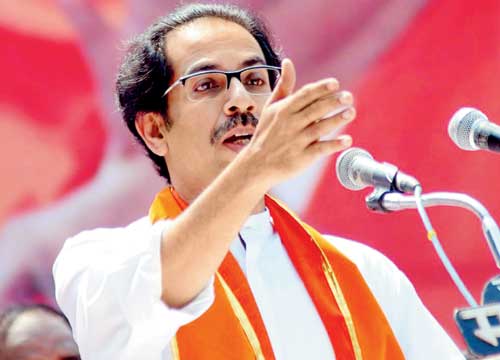
"If you feel that I have lost your confidence, then I will step down. I am ready to leave this stage," Uddhav said.
Though he did not mention it, his statement came against the backdrop of indirect criticism of his relatively mild style of leadership by the veteran Sena leader Manohar Joshi earlier this week.
Incidentally, Joshi, who was present on the dais today, had to leave before the main function began when party workers shouted slogans against him.
Targeting NCP chief Sharad Pawar, Uddhav said in his speech that the latter was still nursing his prime ministerial ambitions.
"Pawar criticised (Narendra) Modi after he was named BJP's prime ministerial nominee. But what about Pawar who himself has not shed the aspiration of becoming the Prime Minister?" Uddahav asked.
The Sena president also claimed that before nominating Modi as BJP's candidate, Rajnath Singh had called him and sought his assent. "I told him (Singh) that Shiv Sena strongly supports BJP and Modi," Uddhav added.
He also criticised Maharashtra Chief Minister Prithviraj Chavan for government's failure to arrest the killers of anti-superstition activist Narendra Dabholkar.
Referring to Chavan's statement that "fascist" groups could be the culprits in Dabholkar murder case, Uddhav said, "If it was done by the people with fascist ideology, then why has the government still not nabbed the accused?"
Criticising the government for keeping former army officer Srikant Purohit and Sadhvi Pragya Singh Thakur (both accused in 2008 Malegaon blast case) in jail, he said Sharad Pawar had called Ishrat Jahan, the girl who died in encounter with Gujarat police, (an encounter dubbed by CBI as fake) "innocent".
"Does Sharad Pawar have more information than David Coleman Headley, the mastermind in 26/11 terror attacks, who had said that Ishrat was a terrorist?" he asked.
He also asked as to why the culprits of irrigation scam in the state had not yet been arrested.
Referring to Chavan's statement that "fascist" groups could be the culprits in Dabholkar murder case, Uddhav said, "If it was done by the people with fascist ideology, then why has the government still not nabbed the accused?"
Criticising the government for keeping former army officer Srikant Purohit and Sadhvi Pragya Singh Thakur (both accused in 2008 Malegaon blast case) in jail, he said Sharad Pawar had called Ishrat Jahan, the girl who died in encounter with Gujarat police, (an encounter dubbed by CBI as fake) "innocent".
"Does Sharad Pawar have more information than David Coleman Headley, the mastermind in 26/11 terror attacks, who had said that Ishrat was a terrorist?" he asked.
He also asked as to why the culprits of irrigation scam in the state had not yet been arrested.






Comments
Add new comment